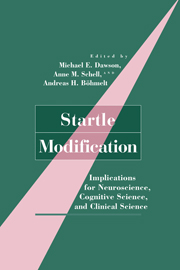Book contents
- Frontmatter
- Contents
- Contributors
- Preface
- Prologue: A Historical Note on the “Discovery” of Startle Modification
- 1 Startle Modification: Introduction and Overview
- PART I BASIC PARADIGMS, METHODS, AND PHENOMENA
- PART II PHYSIOLOGICAL MEDIATION OF STARTLE MODIFICATION
- PART III PSYCHOLOGICAL MEDIATION OF STARTLE MODIFICATION
- 7 Implications of Blink Reflex Research for Theories of Attention and Consciousness
- 8 Affect and the Startle Reflex
- PART IV INDIVIDUAL DIFFERENCES AND STARTLE MODIFICATION
- PART V RELATIONSHIPS WITH OTHER PARADIGMS AND MEASURES
- References
- Author Index
- Subject Index
7 - Implications of Blink Reflex Research for Theories of Attention and Consciousness
Published online by Cambridge University Press: 26 March 2010
- Frontmatter
- Contents
- Contributors
- Preface
- Prologue: A Historical Note on the “Discovery” of Startle Modification
- 1 Startle Modification: Introduction and Overview
- PART I BASIC PARADIGMS, METHODS, AND PHENOMENA
- PART II PHYSIOLOGICAL MEDIATION OF STARTLE MODIFICATION
- PART III PSYCHOLOGICAL MEDIATION OF STARTLE MODIFICATION
- 7 Implications of Blink Reflex Research for Theories of Attention and Consciousness
- 8 Affect and the Startle Reflex
- PART IV INDIVIDUAL DIFFERENCES AND STARTLE MODIFICATION
- PART V RELATIONSHIPS WITH OTHER PARADIGMS AND MEASURES
- References
- Author Index
- Subject Index
Summary
ABSTRACT
Neuroscientists such as Kandel (1978) and Thompson (1986) have exploited the behavioral and neuranatomical simplicity of reflexes in their development of reductionistically approachable model systems of learning and memory. It is argued in this chapter that the field of attention and performance would similarly benefit from the development of a simple model system based on startle and related reflexes. Representative studies are reviewed with respect to the three attentional subsystems distinguished by Posner and Petersen (1990) – the orienting, alerting, and executive networks. To integrate data from reflexology into the broader field of cognitive neuroscience, information processing models that incorporate a vertical architecture are recommended.
The Relevance of Reflexology
Contrasts can help us to grasp amorphous concepts. We may be unsure as to what exactly consciousness is, for example, but we are confident that the comatose patient lacks it, whereas an alert, healthy person has it. Approaching this poorly defined concept from the perspective of several distinct contrasts has helped bring it into clearer view: Experimental comparisons between wakefulness versus sleep, alertness versus anesthesia, masked versus supraliminal priming, ocular dominance versus suppression, blind sight versus visual awareness, and evoked potentials to attended versus ignored stimuli have provided a wealth of relevant data. It is the thesis of this review that direct comparisons of voluntary and reflexive reactions can also provide valuable insights into the neural bases of attention and consciousness.
Neurobehavioral research on reflexes has continued uninterrupted for a quarter of a millennium (e.g., Whytt, 1751, reviewed in Fearing, 1930).
- Type
- Chapter
- Information
- Startle ModificationImplications for Neuroscience, Cognitive Science, and Clinical Science, pp. 137 - 156Publisher: Cambridge University PressPrint publication year: 1999
- 3
- Cited by

